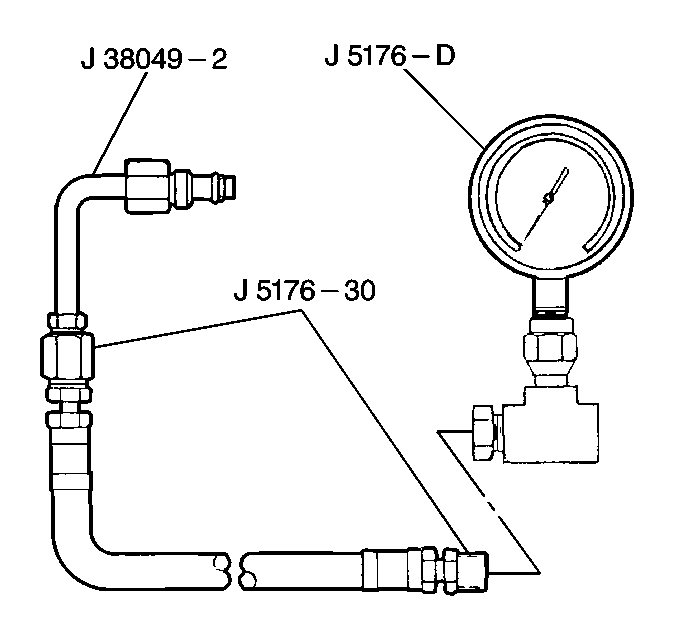Tools Required
| • | J 5176-D Power
Steering Pressure Tester |
You may test the power steering system using one of 2 tools.
The J 5176-D
has the
following characteristics:
| • | Measures the pressure only |
| • | Connects to the power steering pressure gauge using a spare pressure
hose connected to the pump |
The J 25323-B
has
the following characteristics:
| • | Connects to the pressure line at the pump |
When using the J 25323-B
, the following ratings are included in this procedure:
- Disconnect the high pressure line at the pump. Use a small container
in order to catch any fluid that might leak.

- Connect the J 5176-D
or the J 25323-B
to the system.
| • | The J 5176-D
requires that a spare pressure hose connects to the pump. |
| • | The J 25323-B
connects to the power steering pressure line at the power steering pump. |
- Leave the vehicle in Park or Neutral.
- Open the valve on the gauge.
- Start the engine.
- Allow the system to reach the normal operating temperature.
- Inspect the fluid level.
- Add fluid as needed. Refer to
Checking and Adding Power Steering Fluid
.
Important:
| • | Do not move the steering wheel while the engine is running. Moving
the steering wheel while the engine is running gives inaccurate readings. |
| • | Ensure that the pressure reading is less than 1034 (150 psi).
If the pressure is above 1034 (150 psi), stop the engine and
inspect the hoses for restrictions. |
- Note the power steering pressure at engine idle. If you use the J 25323-B
, you may also measure
the power steering flow rate.
Important: DO NOT leave the valve fully closed for more than 5 seconds.
Damage to the pump may occur.
- Fully close the valve 3 times. If you use the J 25323-B
, record the pressure and flow readings
each time the valve is closed.
| • | Each of the pressure readings should show at least 6895 kPa
(1000 psi). Ensure that the three readings are within 345 kPa
(50 psi) of each other. |
| • | If the pressure readings are high enough, and are within 345 kPa
(50 psi) of each other, the pump is functioning properly. |
| • | If the pressure readings are high enough but not within 345 kPa
(50 psi) of each other, the flow control valve in the pump is sticking.
Complete the following steps: |
| 2. | Clean the valve using a crocus cloth or a fine hone. |
| 3. | Flush any dirt contained in the system. |
| • | If the pressure readings are less than 6895 kPa (1000 psi),
replace the flow control valve. |
| • | Reinspect the system. If the readings are still low, replace the following
components: |
- If the pump is OK, perform the following steps:
| • | Turn the steering wheel to both stops. |
| • | Use the J 25323-B
in order to record the highest pressure and flow readings. Compare the readings
with the highest pump pressure (and flow) reading recording. If the pressure
(and flow) at both of the stops is not the same as the maximum pressure,
the steering gear is leaking internally. Disassemble and repair the steering
gear. |
Notice: When adding fluid or making a complete fluid change, always use power
steering fluid GM P/N 1050017 or equivalent meeting GM
Spec. No. 9985010. Failure to use the proper fluid will cause hose
and seal damage and fluid leaks.
- After you complete any of the repairs and/or removal of the gauge, bleed
the system of air.
- Inspect the power steering fluid level. Add fluid as needed.

